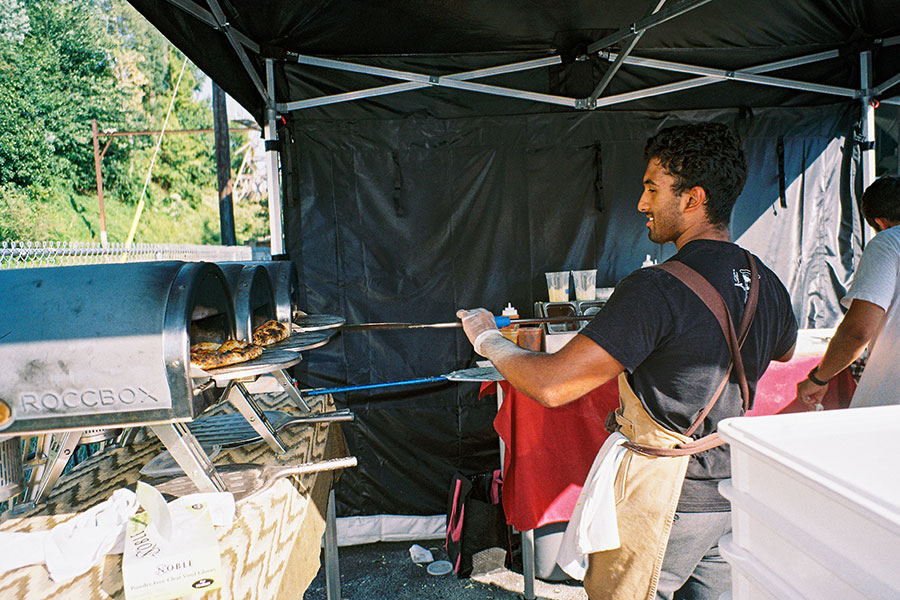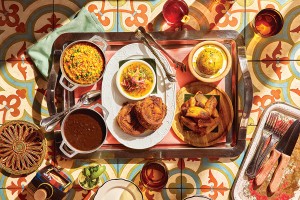Meet the 20-Year-Old Pop-Up Star Taking Over the Old Eeva Space
Viraj Thomas has been working pop-ups and collabs since he was in high school. Now he's about to make his brick-and-mortar debut.

Viraj Thomas of Char hosting a pop-up at Mish Mish / Photography by K.C. Tinari
“I get passionate and obsessive,” Viraj Thomas tells me on the phone. He talks fast. And he talks a lot. He tells me he was into running before he was into pizza — distance running, track, cross-country — but that changed a few years ago when he got into pizza. His story is a pandemic story, kinda. A success story, still in its early stages. But mostly, it’s a pizza story. About a very young man who found a thing that fascinated him and then found himself chasing it to what are honestly, kind of unbelievable ends. “I wanted to be great at something,” he says. “Pizza was the conduit.”
Then he pauses.
“I thought it would be a lot easier to do than it was.”
Which is absolutely the hubris of youth talking. Which is absolutely the amateur’s fallacy of seeing a total pro make something look easy and believing, obviously, that it must actually be easy. Luckily, Viraj isn’t that guy now.
That line? I thought it would be a lot easier to do than it was. That’s him talking about himself in the past tense — about himself as an even younger man than he is today. He was 20 when I got him on the phone after hearing that he was going to be taking over the space at Germantown Avenue and Master Street that used to be Eeva. He’ll be turning 21 around the time his first brick-and-mortar restaurant, Char, opens. And in order to understand how he got to where he is right now, we have to go back a few years to when Viraj first started cooking professionally.
Back when he was still in high school.
December 2018. Viraj is at a Christmas dinner at Zahav with his family. He’d recently seen someone on TV cooking with a small, portable, at-home pizza oven, and he thought it looked like fun. “So I’m there,” he says, “and I’m pitching them hard about this oven.” They could make bread with it at home, he tells them. Their own pizza, whatever they wanted. Viraj was already fixated. He said he wanted one the minute he saw it. “It was just, ‘Oh, wow. I want one,'” he tells me. Specifically, it was a Tom Gozney Roccbox — a small thing, gas-fired with an optional wood-burning conversion, available in gray, green or black, and sold with its own “professional-grade pizza peel.” It was $499 plus tax then, with free shipping (cover sold separately), relatively a lot of money depending on where you are in life. For Viraj — for Back-Then-Viraj — it was a LOT of money. Because he was 15 years old.
Flash forward a few months. Viraj starts working. He does jobs that have nothing to do with pizza and nothing to do with the restaurant industry. He works as a custodian at an elementary school. He applies at Target, hoping he’ll get a gig working inside, but instead becomes one of those guys who has to chase down carts in the parking lot. And the Target he’s working at? It’s on a hill, so he hates it. It’s the summer of 2020. The first pandemic summer. The world is a very strange place. And Viraj makes a decision: He’d had his eye on that Gozney Roccbox for a long time. It fascinated him. The idea of making his own pizzas fascinated him. Cooking in general, sure, but pizza in particular. There was a science there — some chemistry, some physics, some math — but also art. Also magic. “It was something I really wanted,” he explains. “So I bought it for myself.”

Thomas using three Gozney Roccbox pizza ovens in Char’s pop-up tent.
That was August of 2020. His first oven. He’d never used one before in his life. But like the man said, he was passionate. Obsessive. He worked that oven like he’d rented it — teaching himself, on the fly, how to make pizza. How to do something that, for a lot of pizza nerds, is less like a craft and more like a religious calling.
Digression: Viraj will talk to you for an hour about exactly how he makes his pizzas if you ask. He’ll talk to you about rise and fermentation, crust thickness and leoparding. He loves that shit. If he has a weakness as a pizzaiolo (documented at length on his Instagram and by people who have worked alongside him), it’s that he talks to the customers too much. “I don’t believe in any of the bullshit,” he explains. “Oh, this is a family secret, a trade secret. No, I’ll tell you about anything.”
He and I talk about the science a little bit, the technique. Viraj knows his stuff. More, he has a prodigy’s lack of concern for tradition or classicism. I’ve seen pizzas he’s done with entire slices of lunchmeat on them, with bacon and egg, with brisket and fresh mozz, with big, bloated crusts and all the toppings massed up in the middle. But I’m more interested in other things.
So August of 2020, he gets his first oven. By December of the same year, he’s earning — selling pies and slices to his neighbors and his classmates because he’s still in high school. By November of 2021, he’s a legit professional, doing pop-ups at Attic Brewing Company and Wissahickon Brewery. He has two ovens at this point, a couple folding tables, a tent, a name. He calls his business Char, which is simple, memorable and apt all at the same time. He documents just about everything on Instagram. The waits for his pies can stretch to 45 minutes, an hour — partly because he likes to talk, partly because he can only make one pizza per oven at a time, partly because the demand is high and the lines are long.
“Look,” he says. “Okay … So I saw that other people had done it, right? I saw them doing pop-ups and stuff. And I thought, I can do that.”

Char’s pop-up with Paffuto
That line about how he thought it would be a lot easier than it was? THIS is the moment he’s talking about. Making a pizza is easy. Dough, fire, sauce, cheese. Cinch. Making a good pizza, though, is hard. And making a great pizza is art, and art takes work. Time. Experience. More than that, learning how to make money making art is its own other thing. When you’re 15 and staring down a $500 pizza oven you saw in an ad, everything looks easy because you’re not thinking about what you’re going to do when you run out of ingredients an hour into a gig that you promised would last for five, or how to do the job at all when the winds are blowing across an open beer garden at 20 miles per hour and your tent blows away. You’re not dreaming of the endless inventiveness that’s required, balanced against the need for consistency. Everything is hard if you want to be great at it. And Viraj wanted to be great.
He tells me he had no other plans, really. No real Plan B. “I didn’t want to go to college,” he says. “What I wanted was to do a pop-up version of what the original Beddia was. I wanted to make the best pizza ever.” Then he backpedals just a bit. “I wanted to make the best version I can make.”
November 2021. He starts doing pop-ups. Tabachoy, Paffuto, El Chingon and Mish Mish, where owner Alex Tewfik tells me that Viraj is “the most ambitious 20-year-old I’ve ever met.” Doe-eyed, sure, but also good. We talk for a minute and agree that the whole thing is more than a little bit bonkers. There have been absolute veteran 35-year-old chefs who have tried what Viraj is attempting and absolutely run their shit into the dirt. But not him. Alex says it’s preposterous, but he means it in the best possible way. And I completely agree.
For three years, Viraj does the circuit. He cooks everywhere they’ll let him. He does residencies and pop-ups. Collabs. He buys a van to haul his increasingly complicated set-up around, but never does the food truck thing. He’s a tent guy when he doesn’t have someone else’s roof over his head. He’s bootstrapping it the whole way.
And then, all of a sudden, he does the craziest thing yet. 20 years old, and he walks into the strange, split location at 310 Master Street that used to house Eeva and still houses a small ReAnimator Coffee outpost that only operates until 3 p.m., and he says, Yeah, this is going to be my restaurant.
I ask him why. Why that place? And he doesn’t have a great answer. Or rather, he doesn’t have a complete answer, though the answer he gives me might be the only one that matters.
“It felt like a real restaurant.”

When Eeva’s crew bailed, what they left behind was most of a functioning restaurant. Marble-topped tables, a nice counter in front, big windows, a built-out kitchen made for making pizzas. It wasn’t perfect, of course, but the essentials were all in place. “We saved money, time, all of that,” Viraj says.
And the best thing? “Now my restaurant wasn’t going to blow away.”
So he signed the paperwork. He tells me what it cost him to get into the space, pass all his inspections and get it to the point where he feels comfortable opening, and the number is shockingly low. He did it with his own money, with small loans from friends and family and with help from his brother, who came down to help him get the space cleaned up and built out the way he wants it. It isn’t perfect, he tells me, but it’ll work — which is maybe the smartest thing he says to me all night. He says that he could’ve spent months tinkering with things, doing this and that, but everything he did would’ve cost him more money, and he didn’t want to spend any more money because every dollar more he spends is a dollar more he has to make back, and every day he isn’t open is a day he’s bleeding cash.
There were delays. His original target was July 31st, then August 1st, then August 7th. August 14th is the date he gives me. “I think August 14th feels reasonable.” Which, if he makes it, will be a 15-day delay, all told. I’ve written about places lately that have been delayed for two years. But Viraj is sweating two weeks. And at this point, I want to loan the kid 50 bucks myself if it’ll help him shave a day off that. I wish nothing but the best for him.
When he does open, the menu will be pizza-focused, with a tiramisu that he’s been working on, maybe some meatballs. No pasta, though. He doesn’t like pizza places that also do pastas. He feels like it splits their focus. He tells me that even though he technically has access to the whole space after 3 p.m., he’ll be working only with the Eeva half of the restaurant when he opens, but then stops, corrects himself, says it’ll only be “that part of my restaurant, I guess,” and then he laughs. It’s still weird for him to call it that. There’s a part of him that can’t believe any of this is happening.
But it is. And he’s going to have to get used to it quick. Because opening day is right around the corner.


